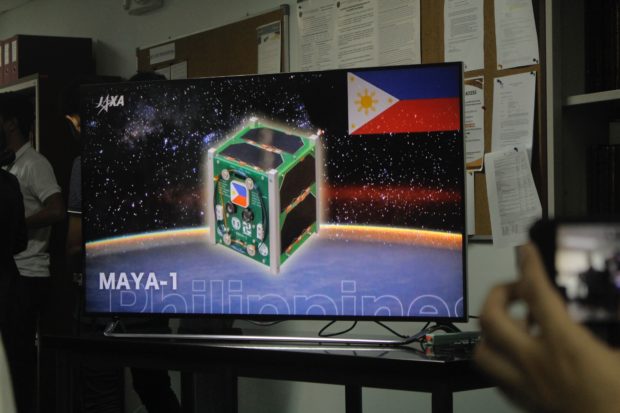PH’s Maya-1 CubeSat deployed into Int’l Space Station
The Cube satellite (CubeSat) “Maya-1”, which will aid the Philippine government in identifying natural hazards based on geographical locations, has been deployed into orbit from the International Space Station (ISS) on Friday afternoon (Manila time).
During a program held at the University of the Philippines (UP) Electrical and Electronics Engineering in Diliman, Quezon City, the actual deployment of Maya-1, developed by Filipino engineers in Japan, was seen through a live feed from the ISS.
Department of Science and Technology (DOST) Secretary Fortunato dela Peña witnessed the event, along with UP President Danilo Concepcion, Chancellor Michael Tan, other officials from UP and the Japanese embassy.
The country’s CubeSat which measures just 10 centimeters on all sides, was released along with Bhutan’s BHUTAN-1 and Malaysia’s UiTMSAT-1 from the “Kibo” module, using the Japanese Experimental Module Small Satellite Orbital Developer (J-SSOD) of Japan Aerospace Exploration Agency (JAXA).
It was the same module used to launch Diwata-1 last March 2016.
Several minutes after the deployment, it was confirmed that all three satellites were healthy and have responded to JAXA’s Tsukuba Space Center (TSC). UP professors will try to connect with Maya-1 within Friday, as it is expected to pass over the country by 8:01 p.m.
The three CubeSats were a part of the Joint Global Multi-Nation BIRDS Satellite Project (BIRDS-2), a project of the Kyushu Institute of Technology in Japan.
Preventing hazards
According to the Philippine Scientific Earth Observation Microsatellite (PHL-Microsat) which heads the country’s satellite programs, Maya-1, costing about $2.5 million, will provide data which scientists and government agencies can use for its geographical hazard map.
Equipped with a camera, Maya-1 can be fed with data from a radio site on the ground and it can throw the sent data to another ground site in a quick manner.
“Among the missions of Maya-1 is the demonstration of the Store and Forward (S&F) System for 1U cubesats. The S&F is a remote data collection system (RDCS) wherein a satellite collects data from remote ground segments (GST) within its footprint, store it, and forward it to any member Ground Station (GS),” PHL-Comsat said.
“Some of the possible applications of the S&F system include collecting data that can be used to generate early warnings for landslides and flash-floods, complementing systems for monitoring health conditions of people in remote areas, and systems for tracking endangered species and fish vessels,” it added.
Professor Joel Joseph Marciano Jr. said that amateur radio enthusiasts can also contact people in other areas through the CubeSat.
According to Marciano, Maya-1 was named after the species of the bird because of its agility and pervasiveness. The CubeSat was transported to the ISS through the SpaceX’ Falcon 9 CRS 15 rocket on June 29, 2018. /vvp
